The Difference Between Sugar And Snickerdoodle Cookies
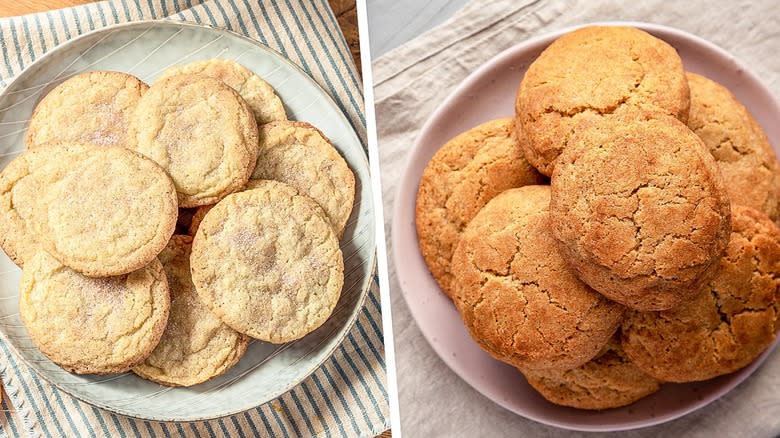
When do the differences between two types of cookies hit the point where one stops being a version of something and becomes its own thing? Sugar cookies are so simple that they feel like they could be the basis for every other cookie out there, but nobody in their right mind would call a chocolate chip cookie a type of sugar cookie. These distinctions are undoubtedly a bit arbitrary, and in the end, it all seems to come down to what you are primarily looking for in a cookie.
An oatmeal cookie should be about oatmeal, and a black and white cookie should be all about showcasing those dueling flavors on the same baked good. And we can all probably agree that we're looking for something very specific from both sugar cookies and snickerdoodles, despite how similar the two are when they start their journey to the oven. It's a bit reductive to say that sugar cookies are about sugar, but the properties of granulated white sugar really do inform every aspect of them.
It creates their clean, sweet flavor and the specific textural contrast that makes them so satisfying to eat. Snickerdoodles' name doesn't give much away except for one thing: These cookies are all about fun and they should have a vibrant flavor that represents that. Sugar cookies are generalists and snickerdoodles are specialists -- and each has different characteristics that help them fill these respective roles.
Read more: 30 Types Of Cake, Explained
What Is A Sugar Cookie?
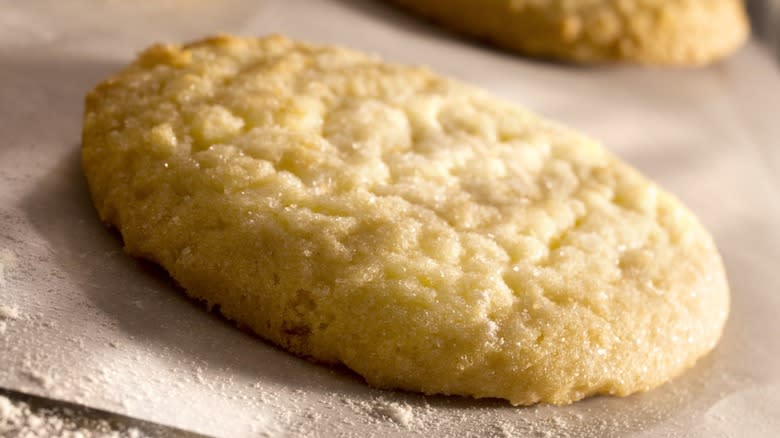
Today, when we think of cookies, we just automatically assume there is sugar in them. This can make the name "sugar cookie" seem a bit redundant. But there is a good reason why they developed as their own category. Sugar used to be an extremely rare, expensive ingredient when the forerunners of European cookies were first developed in the Middle Ages. Instead, local sweeteners like honey, along with spices and fruits, were the main flavoring agents of the day.
It wasn't until the 17th century that sugar started becoming more common, and it wasn't until the 19th century that it became affordable to the masses. It was during that era that what we think of as sugar cookies in America first took shape. The creation of hard, simple sugar cookies is credited to German immigrants around Nazareth, Pennsylvania, with early versions called the Nazareth, or Amish, sugar cookie.
Modern sugar cookies are not totally uniform in style. They can vary in texture or toppings, but they still get all or most of their flavor from white sugar and are made with a simple combination of sugar with eggs, flour, butter, and a leavener such as baking powder. Generally, the only other flavor used might be some vanilla for a little depth, but anything beyond that and you are probably already turning your sugar cookie into something else entirely.
What Is A Snickerdoodle?
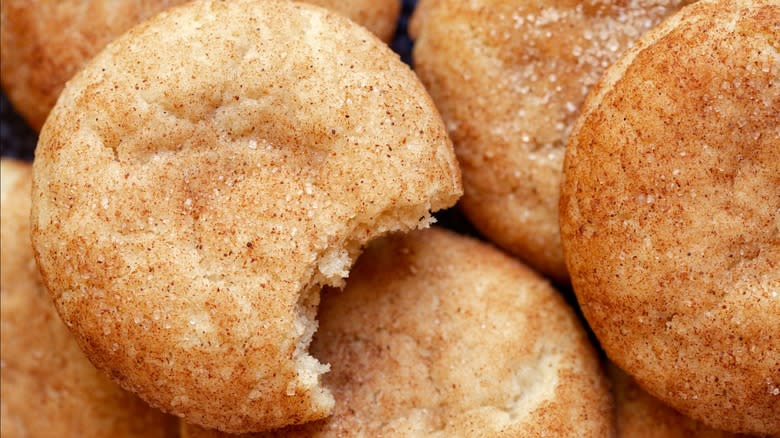
The birth of snickerdoodles can be traced a little more clearly than the general sugar cookie. They date back to 19th century America and took off in popularity late that same century. Cookies with similar flavors to snickerdoodles were brought to the U.S. by German and Dutch immigrants and were known in Mennonite and Amish communities. Some historians believe the name even comes from a German word meaning "crinkly noodle" or "snail."
Originally, snickerdoodles were closer to a version of coffee cake, which has impacted some of their characteristics to this day. But they evolved into more convenient drop cookies in the early 20th century. During World War 2, shortening became a common ingredient, taking the place of butter, and this persisted for a while. So, depending on your age, those may be the snickerdoodles you are thinking of, but most recipes you see today are once again made with butter.
The defining ingredient in a traditional snickerdoodle is cinnamon, which is where most of the cookie's characteristic flavor comes from. There are several other ingredients that can be added to snickerdoodles, such as cream of tartar, that further differentiate them from sugar cookies. But the cookie itself does share a very similar base of eggs, white sugar, butter, and flour. Snickerdoodles also have a signature cracked, crinkly crust on the top of the cookie, which makes them instantly identifiable.
Snickerdoodles Should Be Moist And Chewy
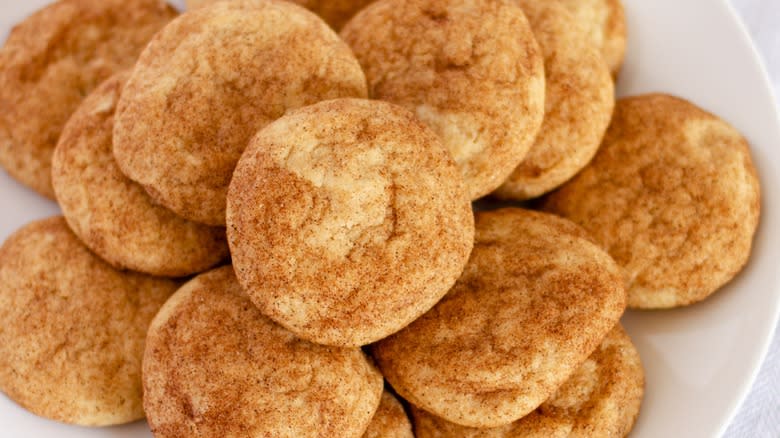
Despite the two cookies having very similar ingredients, snickerdoodles and sugar cookies can often have quite different textures. As is the case with their flavor, snickerdoodles have a more singular style when it comes to texture. The classic snickerdoodle is soft and chewy, with a moist, almost cakey interior. While the cookie might get a bit crispy around the edges, you aren't looking for a fully crunchy snickerdoodle that snaps when you bite it.
Historically, one big difference in ingredients that was added specifically for this reason is cream of tartar. The chemical makeup of cream of tartar inhibits the formation of sugar crystals as the cookie bakes and maintains its soft texture. Many snickerdoodle recipes you'll find these days will omit the cream of tartar, but they still need to find a way to keep the cookie soft. It can be accomplished using other additions like coconut oil.
Sugar cookies, meanwhile, have a wider range of acceptable textures. Some are cakey, like the versions you'll find in supermarkets that are covered with a thick layer of frosting. Others, like many homemade Christmas cookies, are harder to the point of being crunchy. Cookie texture can vary greatly based on the ratio of ingredients like butter and sugar, or how they are baked, so even something as simple as a sugar cookie can produce a wide range of outcomes. It's the sugar flavor, not the texture, that defines it.
Sugar Cookies Can Be Plain Or Decorated
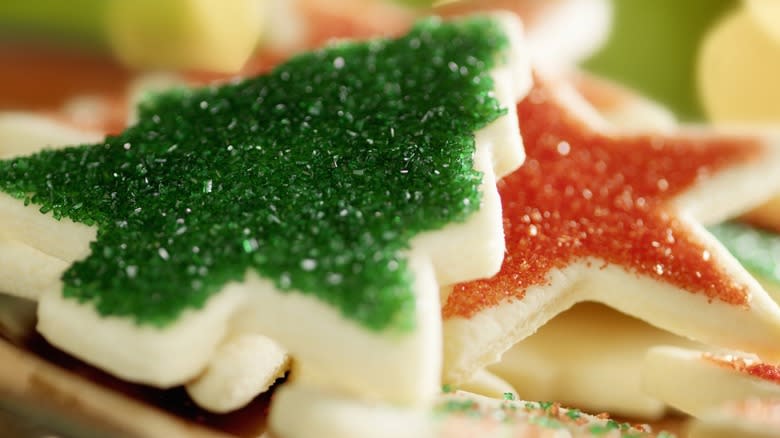
The popular image most people have of sugar cookies is the decorated variety. In fact, their simplicity lends them to being the basis for many decorative cookies. Toppings can range from thin icing to thicker buttercream frosting, or even ingredients that add texture like sprinkles or colored sanding sugar. And, of course, sugar cookies are frequently cut into unique shapes as well, because they are usually rolled cookies, not drop cookies that melt into circles like chocolate chip.
But once again, none of these things explicitly makes a cookie a sugar cookie. A well-made sugar cookie is still delicious plain and simple -- round, unadorned sugar cookies are just as much the real thing as any decorated version. Snickerdoodles, on the other hand, only have one common presentation, and that is the iconic cracked top dusted in cinnamon sugar.
With so much focus on its spiced flavor, any other toppings or decorations would distract or cover up the cinnamon topping. And, as drop cookies, they are also always circular in appearance as well. It's one of the most recognizable and unchanging appearances of any cookie out there. While we don't want to be overly traditional, there simply isn't the variety of styles in snickerdoodles that you see in sugar cookies.
Snickerdoodles Have A More Spiced Flavor
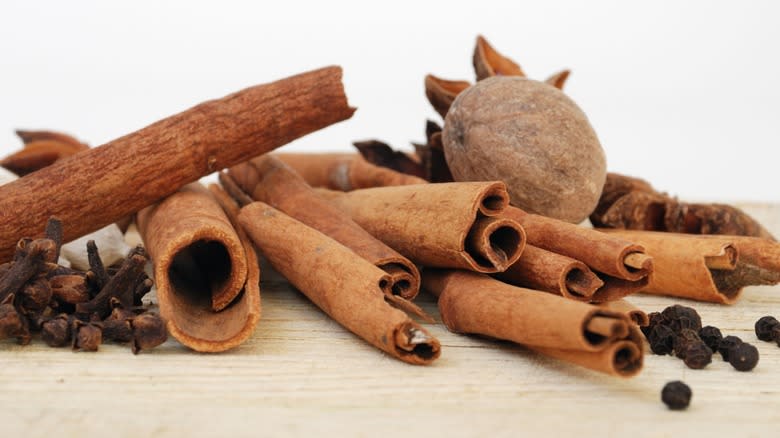
The addition of cinnamon is the clear distinguishing factor between snickerdoodles and sugar cookies. But snickerdoodles don't have to be all about one spice. More than anything, they have the flavor of warm spices, which opens them up to other ingredient inclusions that don't make them any less of a snickerdoodle. Additions like nutmeg or Chinese five-spice can add a little more depth and kick to your snickerdoodles without moving too far from the traditional mold that so many people love. And snickerdoodle dough also has a unique taste as well. The traditional cream of tartar adds a bit of a tang, akin to buttermilk, which helps round out the flavor of an otherwise very sweet cookie.
Sugar cookies lack the spiced flavor of snickerdoodles and focus heavily on granulated sugar, but there are ways to mix these simple cookies up as well. While vanilla remains the secondary flavor in most sugar cookies to help add a little depth, extracts like almond, lemon, or anise can be substituted in to add new flavors and make your sugar cookies more complex and unique. The same goes for any icing or frosting that may be added, which can be flavored with nuts, citrus, maple, or rum. The core flavor shouldn't stray too far from plain sugar, but any of these additions bring undertones that bakers can use to make sugar cookies more satisfying.
Read the original article on Tasting Table

